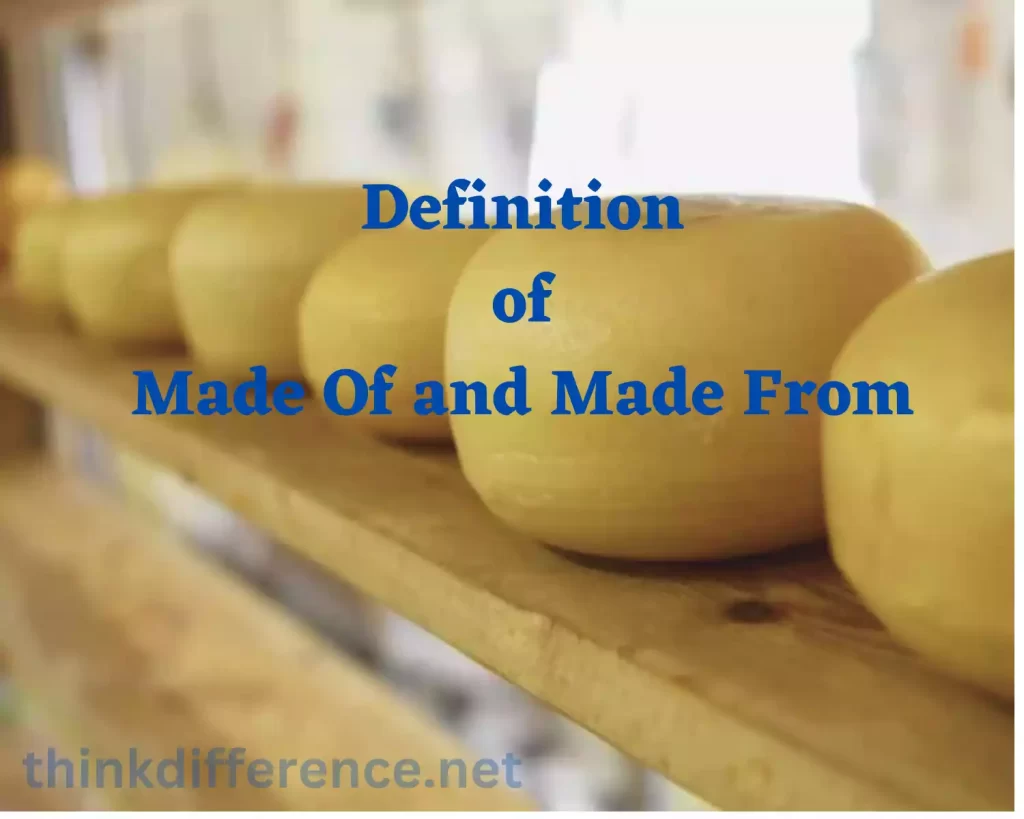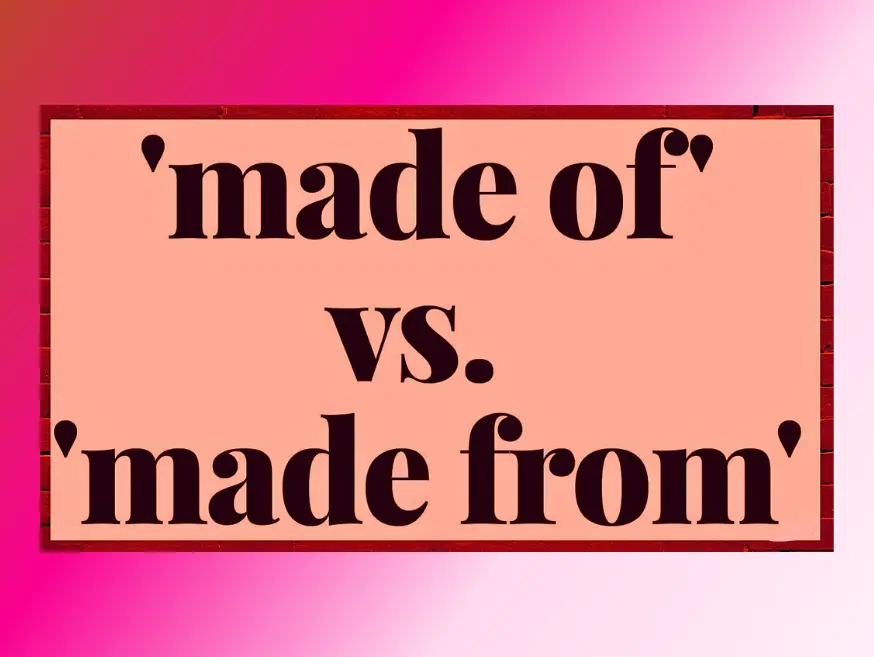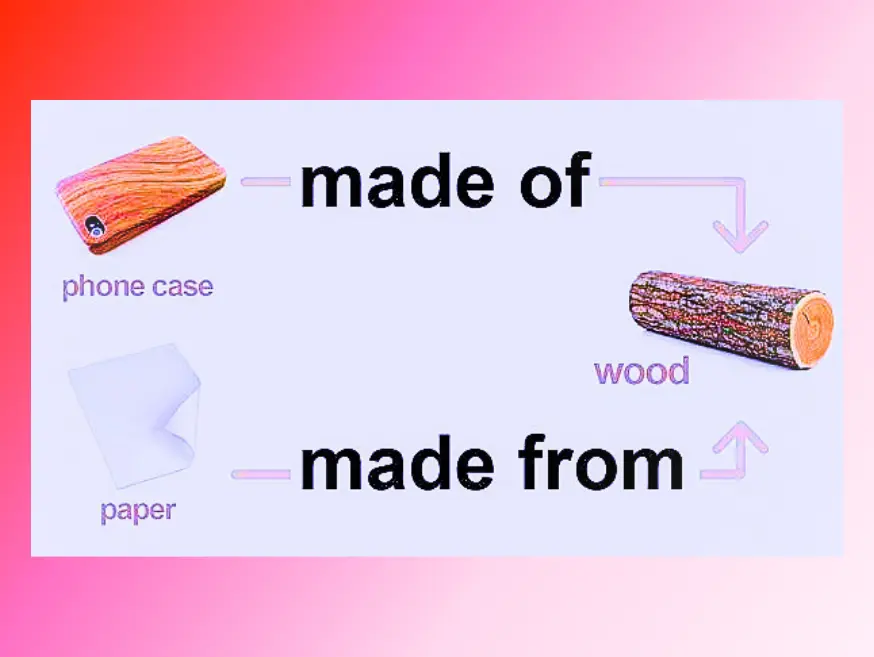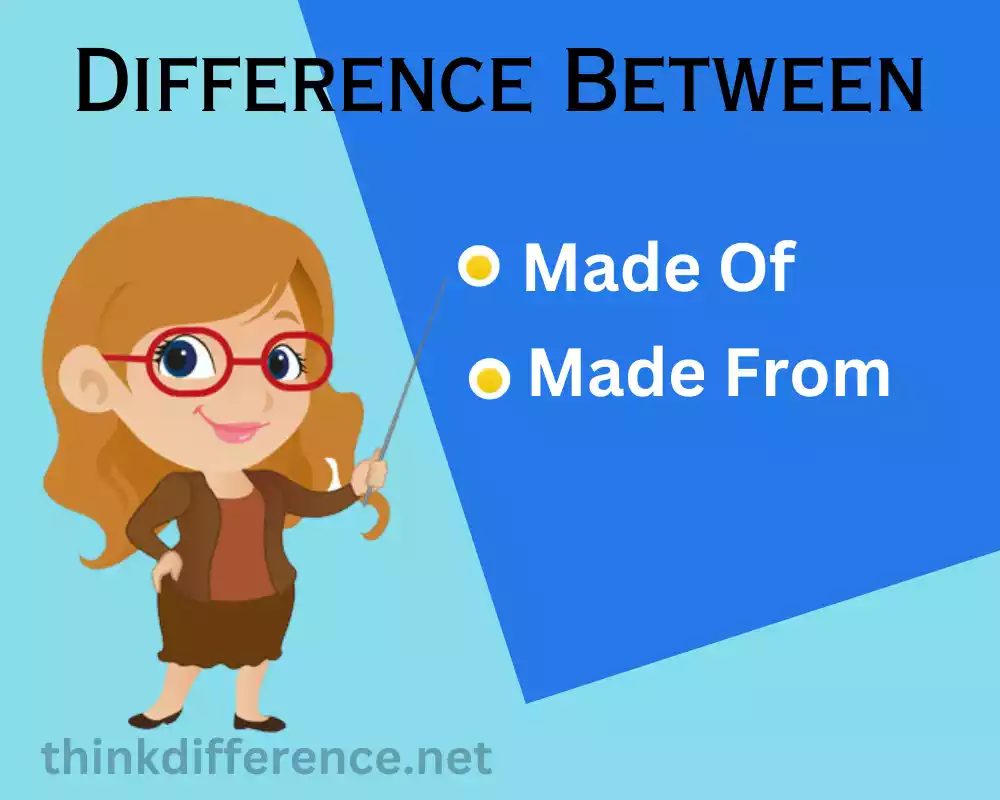Definition of Made Of and Made From
“Made of” refers to the material or composition from which an object or substance was made primarily, typically by manufacturing processes. If something is said to be “made of”, that implies its material was essential in creating its structure or composition and should remain relatively unchanged even through processing and manufacturing; while “Made from” highlights any inherent characteristics and properties inherent within said material that add to overall nature or functionality of that item or substance.

“Made From” refers to an object, substance, or material being altered or transformed into another product or material by means of chemical processing or transformation, often with noticeable physical transformation involving changes to composition, form or state for production of new goods or materials; specifically it implies creation from existing material undergoing significant compositional, form or state changes as it was transformed by being made “of”.
“Made of” underscores this point while simultaneously stressing transition from one type of material into another with some characteristics or properties being retained while noticeable distinctions noted between materials due to chemical processing etc.
Importance of understanding the difference between Made Of and Made From
Understanding the difference between “made of” and “made from” can be extremely useful when discussing products, materials or objects’ origin or composition.
Here’s why this distinction matters so much:
- Accuracy in Description: When communicating about an object’s material or origins, make use of appropriate language so as to provide accurate descriptions without creating confusion or miscommunications. Doing this ensures accurate information is relayed without creating confusion or misperceptions.
- Material Integrity: The “Made of” label highlights the primary materials used in creating an object and highlights their primary properties and characteristics, making an object easier for designers, constructors and manufacturers who prioritize material integrity when developing projects such as designs for architecture or manufacturing products. This attribute plays an invaluable role when working within design-, construction- and manufacturing contexts where material suitability plays an integral part.
- Transformation and Processing: “Made From” refers to the transformation or conversion process that creates products or materials; this distinction is especially crucial in industries that recycle, reuse or convert materials in production processes as it emphasizes their added value and increases production efficiencies.
- Consumer Expectations: To make an informed purchase decision, consumers often rely on accurate product descriptions in order to form their opinion of it. Understanding where a product comes from has the ability to alter perceptions regarding durability, quality and sustainability that affect their buying decision.
- Environmental Implications: Recognizing materials which come from renewable or recycled resources has significant environmental ramifications; by prioritizing items from such sources you can promote responsible consumption practices.
- Compliance with Laws and Regulations: Certain industries may abide by regulations which mandate accurate disclosure or labeling of materials used within their production chain, including understanding what makes up each material (made of, made from and/or with). Doing this helps to comply with regulations while also helping avoid legal complications that might arise from mislabeling issues.
- Language and Cultural Variations: “Made from” can vary across languages and cultures; to effectively communicate across these diverse environments or different audiences it’s crucial that one understands these variations in order to effectively bridge communication gaps between cultures.
Understanding the difference between “made from” and “made of” allows individuals to convey accurate information, make intelligent choices, promote sustainable practices, abide by regulations, and improve communications in both professional and personal contexts.
Differences between Made Of and Made From

As follows is how you can summarize the differences between “made from” and “made of:
- Composition Vs Transformation: The primary distinction is in emphasis – made of emphasizes materials used in making an object while “made from” emphasizes transformation processes wherein something different or original material has been combined together into its final state.
- Material Integrity: If something is “Made from”, that implies its composition or form are unchanged; but “made from” suggests otherwise: they were broken apart or combined with different substances to produce products with distinct properties and attributes.
- Perceptions of Material: Referring to something as being made “from” one particular material may imply that its influence was paramount when creating its function and properties; using “made from” instead suggests it has been altered and may now possess different features than originally planned.
- Processing Focus: “Made of” typically does not emphasize manufacturing or processing steps involved, preferring instead to emphasize material properties inherent to that specific substance. “Made from”, on the other hand, emphasizes transformation; suggesting that original material was modified into another form entirely.
- Implications for Material Properties: Use of “made from”, “made with”, and both terms together can have a dramatic impact on how individuals interpret material characteristics. Describing something as being made “of” material implies its properties define its main features while using terms like “made from” implies alteration to its initial state which might result in different qualities or properties in its end product.
- Sustainability and Environmental Impact: Understanding the difference between “made of” and “made from” is vital when discussing sustainability. “Made From” indicates possible reuse or repurposing opportunities as well as recycling or conversion processes that contribute to reduced environmental impacts.
“Made from” emphasizes composition and inherent properties of original materials while “made out of” emphasizes transformation processes involved in producing products with distinctive properties. By effectively using both phrases you will communicate clearly about which materials were utilized in producing substances or objects.
Common Misconceptions and Clarifications
Following are a few common misperceptions and clarifications related to “made from”.

- Interchangeability: As is often the case, people mistake “made of” and “made from” as synonymous terms. While both terms can sometimes be used interchangeably, their connotations is different and should always be used correctly to provide accurate information.
- Processing Level: There’s often the misperception that saying something was “made of” indicates minimal processing whereas “made from” implies more substantial transformation and processing; both phrases refer to various degrees of transformation depending on context; what differs is how much emphasis is put on original material rather than transformed (made from) material.
- Material Exclusiveness: When discussing objects or substances composed from multiple substances, some individuals tend to assume “made out of” refers only to single materials while “made of” implies multiple ones. While both phrases refer to objects composed entirely from one material (made of) while “made form of” covers anything composed from multiple types. Both phrases refer to objects created out of single or combination materials; their distinction lies in whether their focus lies on composition (made of), transformation (made out of), or both simultaneously (made form of).
- Language and cultural variations: Different countries use “made from” and “made up of” in various ways, which makes understanding its cultural and linguistic context essential for accurate usage. Understanding if either term should be translated is also crucial for accurate usage.
- Contextual Considerations: Context and intended meaning may impact whether “made of” or “made from” should be used when discussing certain materials and objects, with sometimes only minute differences between their usages being detectable; to select an optimal choice it is vitally important that we consider all relevant factors and implications associated with each phrase used in conversation.
At its core, communication should always be clear and accurate; using “made from” as it relates to objects, materials, processes or events should ensure this.
Practical Examples
Examples of “made of” and “made from” that help illustrate this distinction include:
Example: Wooden Table
- “Made Of”: The table is made entirely out of solid oak, emphasizing its durability. This unique construction showcases oak’s strength and resilience.
- “Made From”: This table was constructed out of reclaimed wood. Reclaiming means repurposing existing pieces to make into new table materials; hence the phrase.
Example: Paper
- “Made Of”: Each page in this book is composed primarily of paper. This focuses attention on its material properties such as lightness and flexibility as an important consideration when creating pages for books.
- “Made From”: The “Made from” statement emphasizes that paper produced from recycled fibers. This helps highlight how used paper can be converted to new product.
Example: Plastic Bottle
- “Made Of”: To illustrate its primary material of construction – Polyethylene Terephthalate or PET plastic – as part of its make up. PET’s durability and transparency is highlighted through this bottle’s construction.
- “Made From”: This bottle was constructed out of recycled plastic. This means the material used came from previously recycled sources; emphasizing how recycling discarded plastic creates new products.
Example: Fabric
- “Made Of”: To emphasize cotton’s essential role in its manufacturing process, this shirt was constructed entirely out of it and covered by this article about its composition, properties such as softness and breathability.
- “Made From”: This fabric was manufactured using recycled polyester fibers that have been turned back into fabric by upcycling efforts. By doing this, this process highlights how old polyester can become something entirely new!
These examples demonstrate how our understanding of materials and processes used to construct objects or substances changes depending on whether we describe them using “made from” or “made of.”
Conclusion
The phrases “made of” and “made from” might seem similar, but they convey different meanings. “Made of” indicates a single or predominant material, while “made from” emphasizes the transformation process and the use of multiple source materials. Understanding these distinctions can deepen our appreciation for the materials that shape our world.
As we move forward, sustainable practices and innovative material choices will play a crucial role in shaping a more eco-friendly and resource-efficient society.



